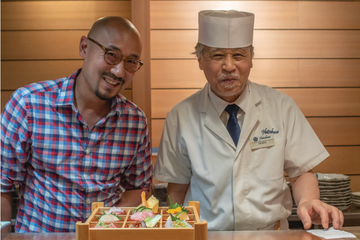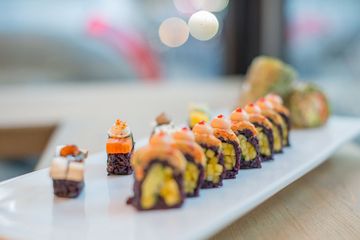“We have always felt that sushi should be a lighthearted kind of food, ” said Keito Sato, whose father, Katsuhide, started Hatsuhana as a way to share this belief. Japanese dining is known for its upscale omakase experiences, in which patrons are served whatever the chef pleases. “What we push at our restaurant is basically the opposite: okonomi, meaning ‘what you like. ’” This unique approach has made Hatsuhana stand out since its inception. Katsuhide emigrated to the U. S. from Japan in the late 1960s, drawn to the American lifestyle and seeking a change of pace. He spent years as a chef in upstate New York before happily joining a Japanese restaurant in midtown. At the age of twenty-five, he was diagnosed with end-stage kidney disease and was told he would need dialysis three times a week. The news put an end to his career as a sushi chef, which required him to work long hours with only one day off, and he was forced to find a new path. “Sushi is what my father knew best in the world. If he couldn’t be a chef, then he realized he had to open his own sushi restaurant. ” Thus, Katsuhide created Hatsuhana and “set the standard for the sushi industry, offering the most authentic sushi possible to New Yorkers. ”Not only did other Japanese eateries take their cue from Hatsuhana’s menu, but Katsuhide was also insistent about procuring the highest-quality ingredients possible. Upon finding that pink-dyed sushi ginger was common in U. S. restaurants, he traveled to California and struck a deal with a vendor for more natural sliced ginger that was free of food coloring. To this day, all fish and food is sourced from “wherever the best place is for the specific item” – be it flying in sushi-grade yellowtail and sea urchin from Japan or salmon from Norway. Today, Katsuhide is retired and resides in Hawaii, while Keito continues to run the show. Though Keito was rigorously trained in sushi making and endeavored to master the art, he devoted much of his attention to working on the business rather than in the kitchen. Most importantly, he continues to promote his father’s overarching philosophy on Japanese cuisine. Instead of viewing sushi as an extravagant indulgence, Harsuhana strives to present the food in a more accessible light. “People should understand the essence of sushi. At the end of the day, it is a snack. ”





